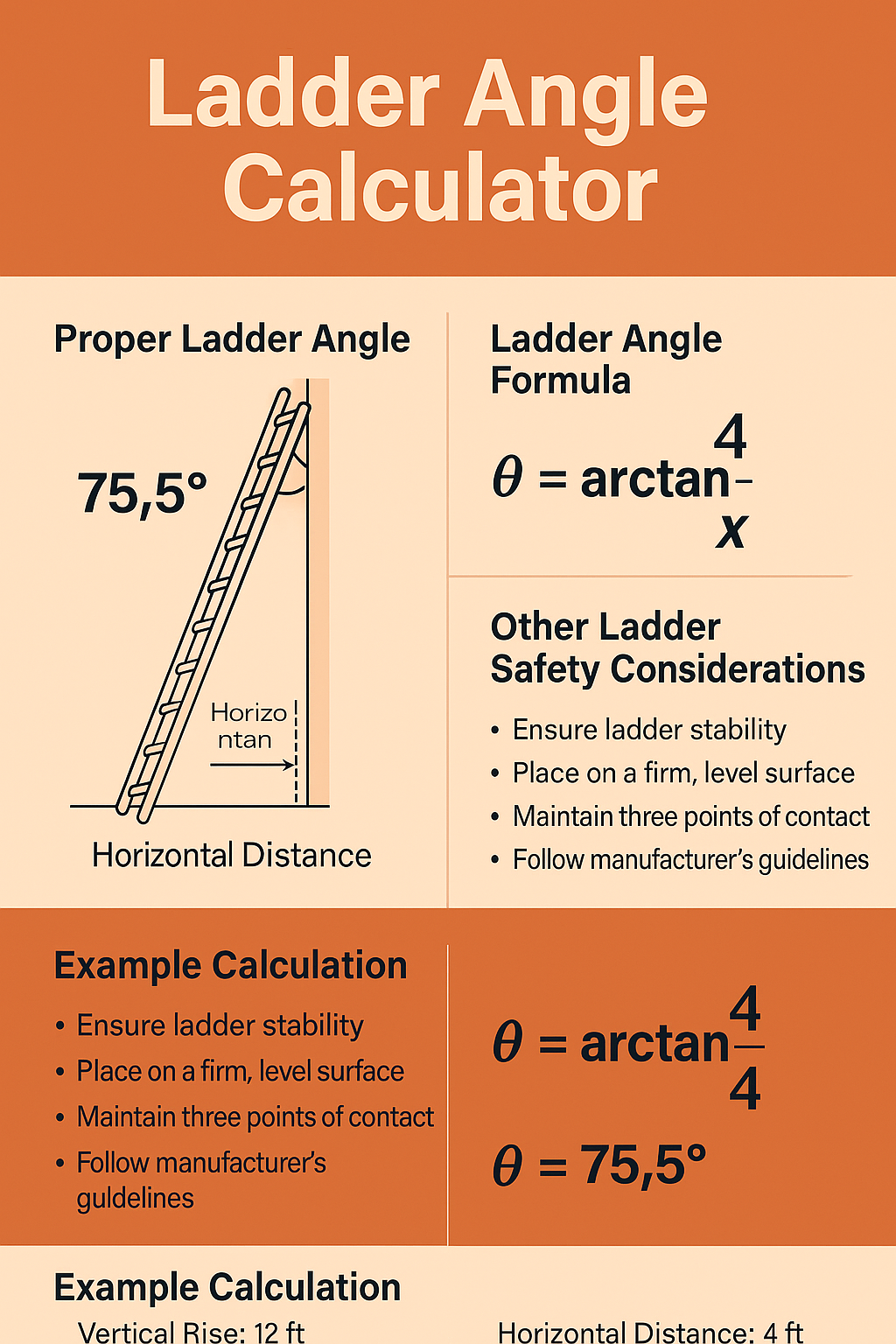Free Ladder Angle Calculator Online
A ladder angle calculator is a practical tool used to determine the safest and most efficient angle for placing a ladder against a vertical surface. Whether you’re working on a roof, cleaning gutters, or painting walls, using Construction Calculators helps you find the correct ladder angle to minimize the risk of slipping or tipping and ensure safe working conditions.
The recommended ladder placement angle is 75.5 degrees, commonly referred to as the 4-to-1 rule. This means for every 4 feet of ladder height, the base should be 1 foot away from the wall.
Ladder Angle Calculator
Why Ladder Angle Matters
Incorrect ladder angle is one of the most common causes of workplace and home injuries. Placing a ladder too steeply increases the risk of falling backward. Placing it too flat can lead to sliding at the base. Using a ladder angle calculator ensures the correct positioning every time.
Proper angle:
- Maximizes stability
- Reduces strain on the user
- Prevents tip-over accidents
- Complies with OSHA safety standards

Ladder Angle Formula
To calculate the ladder angle θ\thetaθ, use this trigonometric formula: $$[
\theta = \tan^{-1}\left( \frac{\text{Base Distance}}{\text{Ladder Height}} \right)
]$$
Where:
- Base Distance = horizontal distance from the wall to the base of the ladder
- Ladder Height = the length from the ground to the top contact point
- θ\thetaθ = angle between the ladder and the ground
Example Calculation
Let’s say your ladder reaches 20 feet up the wall and you follow the 4-to-1 rule: $$[
\text{Base Distance} = \frac{20}{4} = 5\ \text{ft}
]$$
$$[
\theta = \tan^{-1}\left( \frac{5}{20} \right) = \tan^{-1}(0.25) \approx 14.04^\circ
]$$
This is the angle between the ground and the wall. To find the angle between the ladder and the ground, subtract from $$990^\circ – 14.04^\circ = 75.96^\circ$$
So the correct ladder angle is approximately 76 degrees.
4-to-1 Rule Explained
The 4-to-1 rule simplifies the process. For every 4 feet of vertical height:
- Move the base of the ladder 1 foot away from the wall
- This results in an angle close to 75.5 degrees, which is ideal
Examples:
- 8 ft height → 2 ft base distance
- 12 ft height → 3 ft base distance
- 16 ft height → 4 ft base distance
Ladder Placement Calculator Inputs
A ladder angle calculator typically asks for:
- Ladder height (vertical or total length)
- Distance from base to wall
- Optionally, desired angle of inclination
The output includes:
- Angle in degrees
- Required base distance for a given height
- Safety check based on OSHA standards
Ladder Safety Tips
Using the calculator is step one. To ensure safety:
- Place ladder on stable, non-slip surfaces
- Extend the ladder 3 feet above the roofline if accessing a rooftop
- Never stand on the top 3 rungs
- Secure the ladder at the top if possible
- Keep both feet and at least one hand on the ladder
FAQs
Q1: What is the best ladder angle for safety?
About 75.5 degrees or a 1:4 ratio of base distance to height.
Q2: Can I use this for extension ladders?
Yes. Extension, straight, and combination ladders all follow the same angle principles.
Q3: What if my surface isn’t level?
Use leveling feet or ladder stabilizers. Still apply the same angle calculations.
Q4: Can I use this calculator for step ladders?
No. Step ladders are self-supporting and are not leaned against surfaces.
Q5: Does OSHA require a specific ladder angle?
Yes. OSHA recommends an angle of about 75 degrees, which aligns with the 4-to-1 rule.
Final Thoughts
A ladder angle calculator is a small step toward safer and more efficient work. Whether you’re climbing 6 feet or 30, calculating and maintaining the correct angle can prevent serious injury and help you work with confidence. For added accuracy and planning, pair it with tools like the General Construction Calculators, Tank Volume Calculator, and Stair Calculator to cover all measurement and safety angles on your job site. By using the formula: $$[
\theta = \tan^{-1}\left( \frac{\text{Base Distance}}{\text{Ladder Height}} \right)
]$$
you’re just a few numbers away from a safer setup. Always measure, calculate, and double-check before you climb.
